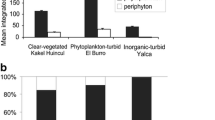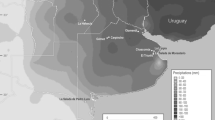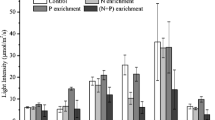Abstract
In order to evaluate patterns of phytoplankton community structure and primary production limitation, we analyzed the phytoplankton communities (chlorophyll a, biovolume, species richness, and primary production) of a set of 20 shallow lakes encompassing a wide range of phosphorus and light levels. The degree of limitation or co-limitation by phosphorus and/or light was estimated using a combined index. We found a direct relationship between irradiance in the water column (I mean) and the light saturation parameter (I k) and, a negative relationship between I mean and total phosphorus (TP) concentration. Lakes at the lowest and highest ends of TP tended to display the simplest phytoplankton communities (i.e., only one or two algal classes accounted for the total phytoplankton biovolume). In contrast, lakes with intermediate TP exhibited a more complex phytoplankton composition. Low values of phytoplankton abundance proxies (chlorophyll a and biovolume), species richness, and primary production could be observed at any combination of phosphorus and light availability. However, the highest values of the previous variables were observed only when the relative availability of both resources was similar. The combined index developed provides a single metric for describing light versus nutrient limitation. The importance of its use is that can be applied to the analysis of clear lakes lacking vegetation and inorganic turbid lakes, besides organic turbid and clear lakes with vegetation.






Similar content being viewed by others
References
Abell, J. M., D. Özkundakci & D. P. Hamilton, 2010. Nitrogen and phosphorus limitation of phytoplankton growth in New Zealand lakes: implications for eutrophication control. Ecosystems 13(7): 966–977.
Allende, L., G. Tell, H. Zagarese, A. Torremorell, G. Pérez, J. Bustingorry, R. Escaray & I. Izaguirre, 2009. Phytoplankton and primary production in clear and turbid shallow lakes from the pampa plain (Argentina). Hydrobiologia 624: 45–60.
APHA, 2005. Standard Methods for the Examination of Water and Wastewater. APHA, Washington, DC.
Bastidas Navarro, M. & B. Modenutti, 2012. Precipitation patterns, dissolved organic matter and changes in the plankton assemblage in Lake Escondido (Patagonia, Argentina). Hydrobiologia 691: 189–202.
Bastidas Navarro, M., B. Modenutti, C. Callieri, R. Bertoni & E. Balseiro, 2009. Balance between primary and bacterial production in North Patagonian shallow lakes. Aquatic Ecology 43: 867–878.
Beardall, J., E. Young & S. Roberts, 2001. Approaches for determining phytoplankton nutrient limitation. Aquatic Sciences – Research Across Boundaries 63(1): 44–69.
Behrenfeld, M. J., O. Prasil, M. Babin & F. Bruyant, 2004. REVIEW In search of a physiological basis for covariations in light-limited and light-saturated photosynthesis. Journal of Phycology 40(1): 4–25.
Begon, M., J. L. Harper & C. R. Towsend, 1987. Ecología. Individuos, Poblaciones, Comunidades. Ediciones Omega, Barcelona: 886 pp.
Bergström, A.-K., 2010. The use of TN:TP and DIN:TP ratios as indicators for phytoplankton nutrient limitation in oligotrophic lakes affected by N deposition. Aquatic Sciences 72(3): 277–281.
Brauer, V. S., M. Stomp & J. Huisman, 2012. The nutrient-load hypothesis: patterns of resource limitation and community structure driven by competition for nutrients and light. The American Naturalist 179(6): 721–740.
Cloern, J. E., 1999. The relative importance of light and nutrient limitation of phytoplankton growth: a simple index of coastal ecosystem sensitivity to nutrient enrichment. Aquatic Ecology 33: 3–16.
Cloern, J. E., C. Grenz & L. Vidergar-Lucas, 1995. An empirical model of the phytoplankton chlorophyll: carbon ratio – the conversion factor between productivity and growth rate. Limnology & Oceanography 40(7): 1313–1321.
Côté, B. & T. Platt, 1983. Day-to-day variations in the spring-summer photosynthetic parameters of coastal marine phytoplankton. Limnology & Oceanography 28: 320–344.
Díaz, M. M., F. L. Pedrozo & P. F. Temporetti, 1998. Phytoplankton of two Araucanian lakes of differing trophic status (Argentina). Hydrobiologia 369: 45–57.
Dickman, E. M., M. J. Vanni & M. J. Horgan, 2006. Interactive effects of light and nutrients on phytoplankton stoichiometry. Oecologia 149(4): 676–689.
Dzialowski, A. R., S.-H. Wang, N.-C. Lim, W. W. Spotts & D. G. Huggins, 2005. Nutrient limitation of phytoplankton growth in central plains reservoirs, USA. Journal of Plankton Research 27(6): 587–595.
Elser, J. J., M. E. S. Bracken, E. E. Cleland, D. S. Gruner, W. S. Harpole, H. Hillebrand, J. T. Ngai, E. W. Seabloom, J. B. Shurin & J. E. Smith, 2007. Global analysis of nitrogen and phosphorus limitation of primary producers in freshwater, marine and terrestrial ecosystems. Ecology Letters 10(12): 1135–1142.
Falkowski, P. G. & J. A. Raven, 2007. Aquatic Photosynthesis, 2nd ed. Princeton University Press, Princeton.
Ferrero, E., M. Eöry, G. Ferreyra, I. Schloss, H. Zagarese, M. Vernet & F. Momo, 2006. Vertical mixing and ecological effects of ultraviolet radiation in planktonic communities. Photochemistry & Photobiology 82: 898–902.
Flynn, K. J., 2001. A mechanistic model for describing dynamic multi-nutrient, light, temperature interactions in phytoplankton. Journal of Plankton Research 23(9): 977–997.
Genkai-Kato, M., Y. Vadeboncoeur, L. Liboriussen & E. Jeppesen, 2012. Benthic-planktonic coupling, regime shifts, and whole-lake primary production in shallow lakes. Ecology 93(3): 619–631.
Gerea, M., G. Pérez, F. Unrein, C. Soto Cárdenas, D. Morris & C. Queimaliños, 2016. CDOM and theunderwater light climate in two shallow North Patagonian lakes: evaluating the effects on nano and microphytoplankton community structure. Aquatic Sciences. doi:10.1007/s00027-016-0493-0.
Gran, G., 1952. Determination of the equivalence point in potentiometric titrations. Analyst 77(920): 661–671.
Harpole, W. S., J. T. Ngai, E. E. Cleland, E. W. Seabloom, E. T. Borer, M. E. S. Bracken, J. J. Elser, D. S. Gruner, H. Hillebrand, J. B. Shurin & J. E. Smith, 2011. Nutrient co-limitation of primary producer communities. Ecology Letters 14(9): 852–862.
Havens, K. E., K.-R. Jin, N. Iricanin & R. T. James, 2007. Phosphorus dynamics at multiple time scales in the pelagic zone of a large shallow lake in Florida, USA. Hydrobiologia 581: 25–42.
Hecky, R. E. & P. Kilham, 1988. Nutrient limitation of phytoplankton in freshwater and marine environments: a review of recent evidence on the effects of enrichment. Limnology & Oceanography 33: 796–822.
Henry, R., M. G. Nogueira, M. L. M. Pompeo & V. Moschini-Carlos, 2006. Annual and short-term variability in primary productivity by phytoplankton and correlated abiotic factors in the Jurumirim Reservoir (São Paulo, Brazil). Brazilian Journal of Biology 66(1B): 239–261.
Hillebrand, H., C. D. Dürselen, D. Kirschtel, U. Pollingher & T. Zohary, 1999. Biovolume calculation for pelagic and benthic microalgae. Journal of Phycology 35: 403–424.
Holm-Hansen, O. & E. W. Helbling, 1995. Técnicas para la medición de la productividad primaria en el fitoplancton. In Alveal, K., M. E. Ferrario, E. C. Oliveira & E. Sar (eds), Manual de Métodos Ficológicos. Concepción, Chile: 329–350.
Irigoien, X. & J. Castel, 1997. Light limitation and distribution of chlorophyll pigments in a highly turbid estuary: the Gironde (SW France). Estuarine, Coastal and Shelf Science 44(4): 507–517.
Izaguirre, I., L. Allende, R. Escaray, J. Bustingorry, G. Pérez & G. Tell, 2012. Comparison of morpho-functional phytoplankton classifications in human-impacted shallow lakes with different stable states. Hydrobiologia 698(1): 203–216.
Kirk, J. T. O., 2011. Light and Photosynthesis in Aquatic Ecosystems, 3rd ed. Cambridge University Press, Cambridge.
Knowlton, M. F. & J. R. Jones, 2000. Non-algal seston, light, nutrients and chlorophyll in Missouri reservoirs. Lake and Reservoir Management 16(4): 322–332.
Kosten, S., M. Vernooij, E. Van Nes, M. D. L. A. González Sagrario, J. G. P. W. Clevers & M. Scheffer, 2012. Bimodal transparency as an Indicator for alternative state in South American lakes. Freshwater Biology 57: 1191–1201.
Kruk, C., V. L. M. Huszar, E. T. H. M. Peeters, S. Bonilla, L. Costa, M. Lürling, C. S. Reynolds & M. Scheffer, 2010. A morphological classification capturing functional variation in phytoplankton. Freshwater Biology 55: 614–627.
Lagomarsino, L., G. L. Pérez, R. Escaray, J. Bustingorry & H. E. Zagarese, 2011. Weather variables as drivers of seasonal phosphorus dynamics in a shallow hypertrophic lake (Laguna Chascomús, Argentina). Fundamental and Applied Limnology/ArchivfürHydrobiologie 178(3): 191–201.
Llames, M. E., L. Lagomarsino, N. Diovisalvi, P. Fermani, A. Torremorell, G. Pérez, F. Unrein, J. Bustingorry, R. Escaray, M. Ferraro & H. Zagarese, 2009. The effects of light availability in shallow, turbid waters: a mesocosm study. Journal of Plankton Research 31: 1517–1529.
Mao, J., Q. Chen & Y. Chen, 2008. Three-dimensional eutrophication model and application to Taihu Lake, China. Journal of Environmental Sciences 20(3): 278–284.
Margalef, R., 1978. Life forms of phytoplankton as survival alternatives in an unstable environment. Oceanologica Acta 1: 493–509.
Marker, A. F. H., A. Nusch, H. Rai & B. Riemann, 1980. The measurement of photosynthetic pigments in freshwater and standardization of methods: conclusions and recommendations. Arch Hydrobiol Beih 14: 91–106.
Naselli-Flores, L. & R. Barone, 2012. Phytoplankton dynamics in permanent and temporary Mediterranean waters: is the game hard to play because of hydrological disturbance? Hydrobiologia 698(1): 147–159.
Padisák, J., L. O. Crossetti & L. Naselli-Flores, 2009. Use and misuse in the application of the phytoplankton functional classification: a critical review with updates. Hydrobiologia 621: 1–19.
Phlips, E. J., M. Cichra, F. J. Aldridge, J. Jembeck, J. Hendrickson & R. Brody, 2000. Light availability and variations in phytoplankton standing crops in a nutrient-rich blackwater river. Limnology & Oceanography 45(4): 916–929.
Platt, T., C. L. Gallegos & W. G. Harrison, 1980. Photoinhibition of photosynthesis in natural assemblages of marine phytoplankton. Journal of Marine Research 38: 687–701.
Queimaliños, C. P., B. E. Modenutti & E. G. Balseiro, 1998. Phytoplankton responses to experimental enhancement of grazing pressure and nutrient recycling in a small Andean lake. Freshwater Biology 40(1): 41–49.
Quirós, R., M. B. Boveri, C. A. Petrachi, A. M. Renella, J. J. Rosso, A. Sosnovsky & H. T. von Bernard, 2006. Los efectos de la agriculturización del humedal pampeano sobre la eutrofización de sus lagunas. In Tundizi, J. G., T. Matsumura-Tundisi & C. SidagisGalli (eds), Eutrofização na América do Sul: Causas, conseqüèncias e tecnologias de gerenciamento e controle. International Institute of Ecology, São Carlos: 1–16.
Rebsdorf, A., 1972. The Carbon Dioxide System of Freshwater. A Set of Tables for Easy Computation of Total Carbon Dioxide and Other Components of the Carbon Dioxide System. Freshwater Biological Laboratory, Hillerod.
Reynolds, C. S., 1984. Phytoplankton periodicity: the interactions of form, function and environmental variability. Freshwater Biology 14: 111–142.
Reynolds, C. S., V. Huszar, C. Kruk, L. Naselli-Flores & S. Melo, 2002. Towards a functional classification of the freshwater phytoplankton. Journal of Plankton Research 24(5): 417–428.
Sakshaug, E., A. Bricaud, Y. Dandonneau, P. G. Falkowski, D. A. Kiefer, L. Legendre, A. Morel, J. Parslow & M. Takahashi, 1997. Parameters of photosynthesis: definitions, theory and interpretation of results. Journal of Plankton Research 19(11): 1637–1670.
Salmaso, N. & J. Padisák, 2007. Morpho-functional groups and phytoplankton development in two deep lakes (Lake Garda, Italy and Lake Stechlin, Germany). Hydrobiologia 578: 97–112.
Sánchez, M. L., G. L. Pérez, I. Izaguirre & H. Pizarro, 2013. Influence of underwater light climate on periphyton and phytoplankton communities in shallow lakes from the Pampa plain (Argentina) with contrasting steady states. Journal of Limnology 72(1): e6.
Schallenberg, M. & C. W. Burns, 2004. Effects of sediment resuspension on phytoplankton production: teasing apart the influences of light, nutrients and algal entrainment. Freshwater Biology 49(2): 143–159.
Scheffer, M., 1998. Ecology of Shallow Lakes. Kluwer Academic Publishers, Dordrecht.
Scheffer, M. & E. H. van Nes, 2007. Shallow lakes theory revisited: various alternative regimes driven by climate, nutrients, depth and lake size. Hydrobiologia 584: 455–466.
Smith, R. E. H. & J. Kalff, 1982. Size-dependent phosphorus uptake kinetics and cell quota in phyoplankton. Journal of Phycology 18(2): 275–284.
Squires, M. M., L. F. W. Lesack, R. Hecky, S. J. Guildford, P. Ramlal & S. N. Higgins, 2009. Primary production and carbon dioxide metabolic balance of a lake-rich Arctic river floodplain: partitioning of phytoplankton, epipelon, macrophyte, and epiphyton production among lakes on the Mackenzie Delta. Ecosystems 12: 853–872.
Steeman-Nielsen, E., 1952. The use of radiocarbon (14C) for measuring organic production in the sea. Journal du Conseil International pour l’Exploration de la Mer 18: 117–140.
Sterner, R. W., J. J. Elser, E. J. Fee, S. J. Guildford & T. H. Chrzanowski, 1997. The light:nutrient ratio in lakes: the balance of energy and materials affects ecosystem structure and process. The American Naturalist 150(6): 663–684.
Sun, J. & D. Liu, 2003. Geometric models for calculating cell biovolumen and surface area for phytoplankton. Journal of Plankton Research 25: 1331–1346.
ter Braak, C. J. F. & P. Šmilauer, 2002. CANOCO reference manual and Cano Draw for Windows User’s Guide: Software for Canonical Community Ordination (Version 4.5). Microcomputer power, New York.
Tilman, D., S. S. Kilham & P. Kilham, 1982. Phytoplankton community ecology: the role of limiting nutrients. Annual Review of Ecology and Systematics 13: 349–372.
Tolotti, M., E. Rott, H. Thies & R. Psenner, 2005. Functional species groups of phytoplankton in relation to lake restoration: a long term study of Piburger See, Austria. Verhandlungen der Internationalen Vereinigung für theorestische und angewandte Limnologie 29: 891–894.
Torremorell, A., M. E. Llames, G. Pérez, R. Escaray, J. Bustingorry & H. Zagarese, 2009. Annual patterns of phytoplankton density and primary production in a large, shallow lake: the central role of light. Freshwater Biology 54: 437–449.
Utermöhl, H., 1958. ZurVervollkommnung der quantitativen Phytoplankton Methodik. Mitteilungen Internationale Vereinigung Limnologie 9: 1–38.
Venrick, E. L. (1978) How many cells to count? . In Sournia, A. (ed), Phytoplankton manual. UNESCO, Paris: 167–180.
Vincent, W. & J. Laybourn-Parry, 2008. Polar Lakes and Rivers. Oxford University Press, Oxford: 364 pp.
Yamaguchi, H., N. Hirade, K. Higashizono, K. Tada, K. Kishimoto, K. Oyama & K. Ichimi, 2015. Light and nutrient limitation on phytoplankton production in the strait of an enclosed coastal sea (Bisan Strait, eastern Seto Inland Sea, Japan). Journal of Sea Research 103: 75–83.
Acknowledgements
We thank Roberto Escaray and José Bustingorry for field assistance. This work was supported by CONICETPIP 00342-2010; PIP 00700-2012; PICT 0775-2013; and by Proyecto Argentino de Monitoreo y Prospección de Ambientes Acuáticos (PAMPA2).
Author information
Authors and Affiliations
Corresponding author
Additional information
Guest editors: Beatriz E. Modenutti & Esteban G. Balseiro / Andean Patagonian Lakes as Sensor of Global Change
Electronic supplementary material
Below is the link to the electronic supplementary material.
Rights and permissions
About this article
Cite this article
Torremorell, A., del Carmen Diéguez, M., Queimaliños, C. et al. Phytoplankton limitation in Patagonian and Pampean shallow lakes: effect of phosphorus and light. Hydrobiologia 816, 91–105 (2018). https://doi.org/10.1007/s10750-017-3181-8
Received:
Revised:
Accepted:
Published:
Issue Date:
DOI: https://doi.org/10.1007/s10750-017-3181-8




